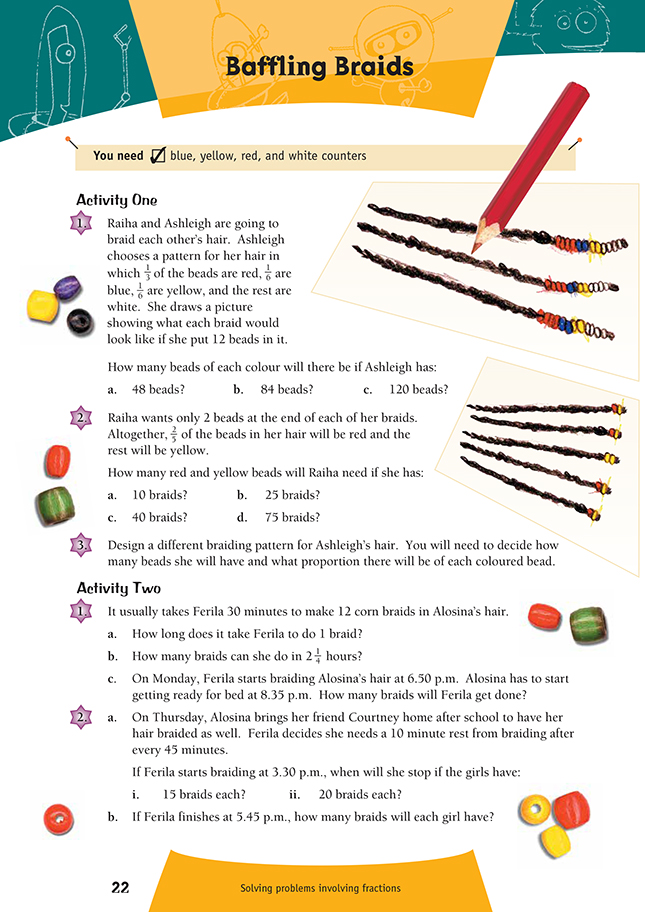This is a level 3 number activity from the Figure It Out series. It relates to Stage 6 of the Number Framework.
A PDF of the student activity is available.
Click on the image to enlarge it. Click again to close. Download PDF (378 KB)
find fractions of whole numbers
solve problems involving fractions
Blue, yellow, red, and white counters
FIO, Level 3, Number, Book 2, Baffling Braids, page 22
Activity One
This activity poses problems involving solving fractions of a set. It can be used with students who are at the counting-on stage through to those at the advanced proportional stage of the Number Framework. It is vital that the students keep in mind the total number of beads that are the unit being used in each problem. You could ask:
“One-third of how many beads are red?”
“How many beads are in the whole set of beads being referred to here?”
Use the picture for question 1 to ensure that the students can relate the fraction of each colour to the whole set. You should ask them to find out what fraction of the set of beads is white.
A fraction circle showing sixths may be helpful to demonstrate the relationship between the thirds and sixths as well as the fraction of the set that is white. For example:
This shows that 2 sections out of 6 are white, so 2/6 of the beads are white. This means that 1/3 must be white.
The students should also compare the fraction for each colour. They should see that the red and white sections are the same and the blue and yellow sections are the same. Encourage them to see that the blue or yellow fraction is half the red or white fraction. That is, 1/6 is half of 1/3.
Students at the counting-on or advanced counting stages may need to use beads or counters and place them on the circle diagram. Once they have done this, help them record the appropriate number sentence, such as 1/6 x 12 = 2 because 12 ÷ 6 = 2.
So that the students can see how to work out numerators greater than 1, ask them “How can we use the fact that 1/6 of 12 equals 2 to work out 1/3 of 12?”
In question 1, ask the students to find a number of strategies to solve the problems. They may write 1/3 x 48 or 1/3 of 48. To help them, you could show them that 1/3 x 48 is the same as 48 ÷ 3.
They may relate 1a, 1b, and 1c to the example of 12 beads in the picture. So the answer to 1a is four times the example because 48 is 12 x 4. The answer for question 1b is 7 times the amount because 84 ÷ 12 = 7, and that for 1c is 10 times bigger.
Question 2 extends the numerator to 2 in 2/5. The students will need to appreciate that 2/5 is 2 x 1/5 and that if 2/5 are red, 3/5 are yellow because the whole set is 5/5. Use a circle diagram showing fifths (Material Master 4-19).
You could encourage the students to make a chart to help them to see the patterns in the questions:
Activity Two
This activity uses fractions greater than 1. The students need to use these mixed fractions so that they do not have the common misconception that fractions are always smaller than 1.
In small groups, the students could discuss ways to begin to solve the problems. In question 1b, they may see that they could use the relationship of 30 minutes for 12 braids as a unit. Then they can find out how many lots of 30 minutes there are in 21/4 hours. There are 41/2 periods of 30 minutes, so 41/2 x 12 = 54 braids. This may be an easier strategy for the students than the conventional way of dividing 135 minutes by 2.5 minutes.
Question 2 is intended to provide a challenge for students moving into the advanced proportional stage. Have the students discuss what is happening in the question and explain it to others in their own words. Check their understanding with questions like: “How many braids will Ferila have to do in question 2a i?” (30) “How long does she take to do 1 braid? How about 10 braids?” “If she starts at 3:30 p.m., when will her first break be?”
The students may see that a good strategy could be to use the fact that 10 braids will take 25 minutes, so 30 braids will take 75 minutes. 75 minutes + a 10 minute break = 85 minutes.
Answers to Activities
Activity One
1. a. 16 red, 8 blue, 8 yellow, 16 white
b. 28 red, 14 blue, 14 yellow, 28 white
c. 40 red, 20 blue, 20 yellow, 40 white
2. a. 8 red, 12 yellow
b. 20 red, 30 yellow
c. 32 red, 48 yellow
d. 60 red, 90 yellow
3. Practical activity. Designs will vary.
Activity Two
1. a. 2.5 min
b. 54. (135 ÷ 2.5 or 12 x 4 + 6)
c. 42. (105 ÷ 2.5). You could work out the time on a number line:
2. a. i. 4.55 p.m. (Ferila will have a 10 min break after 18 braids.)
ii. 5.30 p.m. (She will need two 10 min breaks.)
b. 23


